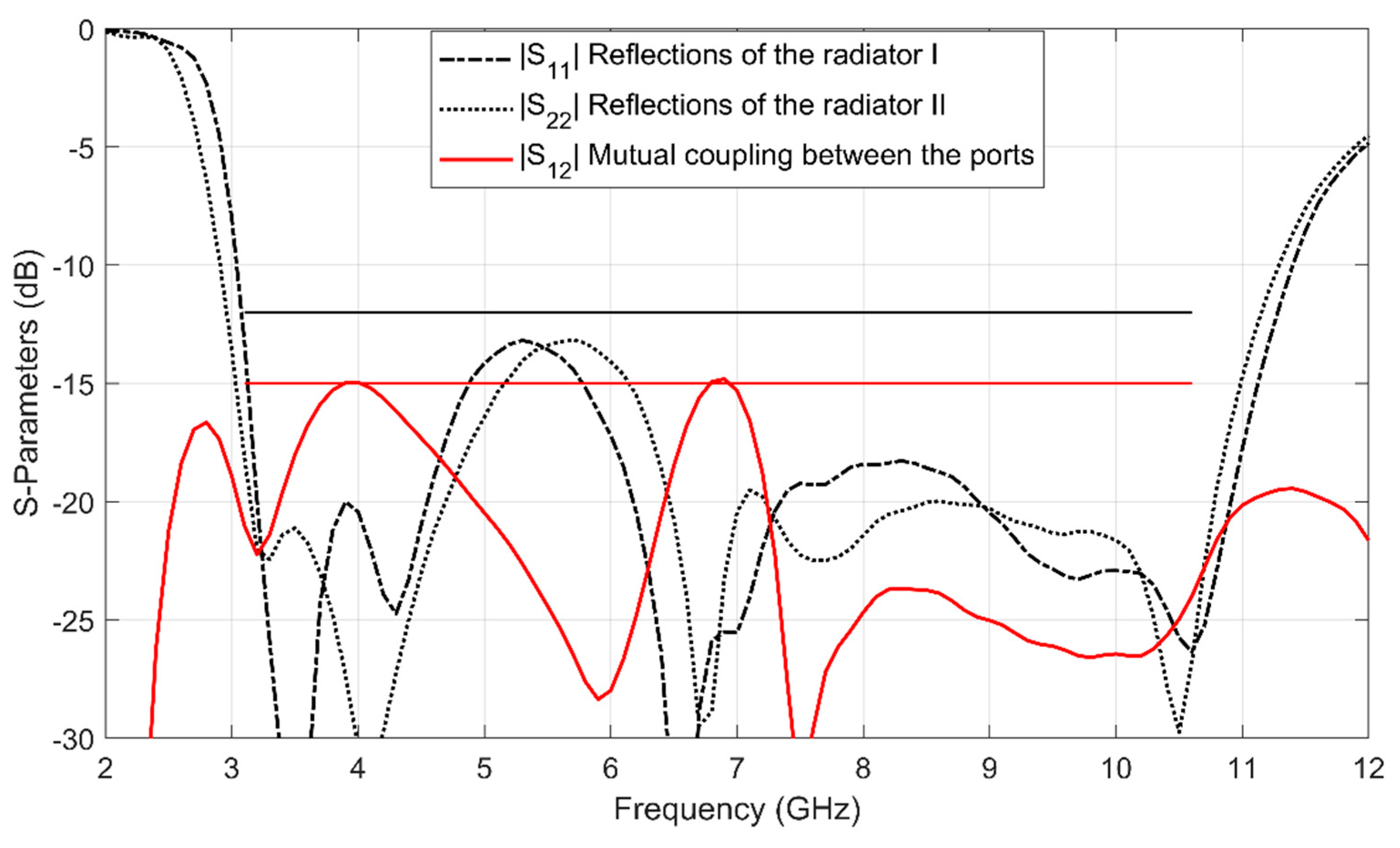Multi-Fidelity Local Surrogate Model for Computationally Efficient Microwave Component Design Optimization
Abstract
:1. Introduction
2. Multi-Fidelity Local Surrogate Model Optimization
2.1. Microwave Component Design Problem
2.2. Multi-Fidelity Local Surrogate Models
2.3. Surrogate Model Optimization with Adaptive Region Updating
2.4. Refinement of Surrogate with Fine Model
2.5. Summary of Multi-Fidelity Local Surrogate Model Optimization
3. Verification Examples and Comparison
3.1. A Microstrip Filter Optimization
3.2. Compact UWB MIMO Antenna Design
3.2.1. UWB Monopole Antenna Optimization
3.2.2. Compact UWB MIMO Antenna
4. Conclusions
Author Contributions
Funding
Conflicts of Interest
References
- Xue, J.; Biswas, S.; Cirik, A.C.; Du, H.; Yang, Y.; Ratnarajah, T.; Sellathurai, M. Transceiver design of optimum wirelessly powered full-duplex MIMO IoT devices. IEEE Trans. Comm. 2018, 66, 1955–1969. [Google Scholar] [CrossRef]
- Kang, K.; Ye, R.; Pan, Z.; Liu, J.; Shimamoto, S. Full-duplex wireless powered IoT networks. IEEE Access 2018, 6, 53546–53556. [Google Scholar] [CrossRef]
- Moscato, S.; Silvestri, L.; Delmonte, N.; Pasian, M.; Bozzi, M.; Perregrini, L. SIW components for the Internet of Things: Novel topologies, materials, and manufacturing techniques. In Proceedings of the IEEE Topical Conference on Wireless Sensors and Sensor Networks, Austin, TX, USA, 24–27 January 2016. [Google Scholar]
- Nauroze, S.A.; Hester, J.G.; Tehrani, B.K.; Su, W.J. Additively manufactured RF components and modules: Toward empowering the birth of cost-efficient dense and ubiquitous IoT implementations. Proc. IEEE 2017, 105, 702–722. [Google Scholar] [CrossRef]
- Rahman, M.; Ko, D.; Park, J. A compact multiple notched ultra-wide band antenna with an analysis of the CSRR-TO-CSRR coupling for portable UWB applications. Sensors 2017, 17, 2174. [Google Scholar] [CrossRef] [PubMed]
- Rahman, M.; Park, J. The smallest form factor UWB antenna with quintuple rejection bands for IoT applications utilizing RSRR and RCSRR. Sensors 2018, 18, 911. [Google Scholar] [CrossRef] [PubMed]
- Lu, H.; Xie, T.; Li, Q. Compact tri-band bandpass filter designed using stub-loaded stepped-impedance resonator. In Proceedings of the IEEE International Conference on Electronics Information and Emergency Communication (ICEIEC), Macau, China, 21–23 July 2017. [Google Scholar]
- Feng, F.; Zhang, C.; Na, W.; Zhang, J.; Zhang, W.; Zhang, Q.-J. Adaptive feature zero assisted surrogate-based EM optimization for microwave filter design. IEEE Microw. Wirel. Compon. Lett. 2019, 29, 2–4. [Google Scholar] [CrossRef]
- Nguyen, P.M.; Chung, J.Y. Characterisation of antenna substrate properties using surrogate-based optimization. Antennas Propag. 2015, 9, 867–871. [Google Scholar] [CrossRef]
- Jin, F.; Dong, J.; Wang, M.; Wang, S. Design of antenna rapid optimization platform based on intelligent algorithms and surrogate models. In Proceedings of the International Symposium on Antennas, Propagation and EM Theory, Hangzhou, China, 3–6 December 2018. [Google Scholar]
- Koziel, S.; Ogurtsov, S. Robust multi-fidelity simulation-driven design optimization of microwave structures. In Proceedings of the IEEE MTT-S International Microwave Symposium, Anaheim, CA, USA, 23–28 May 2010. [Google Scholar]
- Koziel, S.; Ogurtsov, S.; Szczepanski, S. Local response surface approximations and variable-fidelity electromagnetic simulations for computationally efficient microwave design optimization. IET Microw. Antennas Propag. 2012, 6, 1056–1062. [Google Scholar] [CrossRef]
- Koziel, S.; Leifur, L. Simulation-Driven Design by Knowledge-Based Response Correction Techniques; Springer: New York, NY, USA, 2016; pp. 31–36. [Google Scholar]
- Bandler, J.W.; Cheng, Q.S.; Dakroury, S.A.; Mohamed, A.S.; Bakr, M.H.; Madsen, K.; Soundergaard, J. Space mapping: The state of the art. IEEE Trans. Microw. Theory Tech. 2004, 52, 337–361. [Google Scholar] [CrossRef]
- Couckuyt, I.; Koziel, S.; Dhaene, T. Surrogate modeling of microwave structures using kriging, co-kriging, and space mapping. Int. J. Numer. Model. Electron. Netw. Devices Fields 2013, 26, 64–73. [Google Scholar] [CrossRef]
- Alexandrov, N.M.; Lewis, R.M. An overview of first-order model management for engineering optimization. Optim. Eng. 2001, 2, 413–430. [Google Scholar] [CrossRef]
- Salleh, M.H.M.; Prigent, G.; Pigaglio, O.; Crampagne, R. Quarter-wavelength side-coupled ring resonator for bandpass filters. IEEE Trans. Microw. Theory Tech. 2008, 56, 156–162. [Google Scholar] [CrossRef]
- Liu, L.; Cheung, S.W.; Yuk, T.I. Compact MIMO antenna for portable devices in UWB applications. IEEE Trans. Antennas Prop. 2013, 61, 4257–4264. [Google Scholar] [CrossRef]
- Bekasiewicz, A.; Koziel, S.; Dhaene, T. Optimization-driven design of compact UWB MIMO antenna. In Proceedings of the European Conference on Antennas and Propagation (EuCAP), Davos, Switzerland, 10–15 April 2016. [Google Scholar]








| Method | Required Model Evaluation | Number of Model Evaluations | Optimization Cost | |
|---|---|---|---|---|
| Absolute (min) | Relative to | |||
| Direct optimization | Fine model | 397 | 1985 | 397 |
| Original algorithm | Total optimization time | 55 2 N/A | 71.5 10 81.5 | 14.3 2 16.3 |
| Proposed algorithm | Total optimization time | 22 44 2 N/A | 13.2 57.2 10 80.4 | 2.6 11.4 2 16 |
| Method | Required Model Evaluation | Number of Model Evaluations | Optimization Cost | |
|---|---|---|---|---|
| Absolute (h) | Relative to | |||
| Direct optimization | 497 | 53.8 | 497 | |
| Original algorithm | Total optimization time | 161 2 N/A | 4 0.2 4.2 | 38 2 40 |
| Proposed algorithm | Total optimization time | 69 46 69 2 N/A | 1.1 1.1 3.2 0.2 5.6 | 10 10 30 2 52 |
© 2019 by the authors. Licensee MDPI, Basel, Switzerland. This article is an open access article distributed under the terms and conditions of the Creative Commons Attribution (CC BY) license (http://creativecommons.org/licenses/by/4.0/).
Share and Cite
Song, Y.; Cheng, Q.S.; Koziel, S. Multi-Fidelity Local Surrogate Model for Computationally Efficient Microwave Component Design Optimization. Sensors 2019, 19, 3023. https://doi.org/10.3390/s19133023
Song Y, Cheng QS, Koziel S. Multi-Fidelity Local Surrogate Model for Computationally Efficient Microwave Component Design Optimization. Sensors. 2019; 19(13):3023. https://doi.org/10.3390/s19133023
Chicago/Turabian StyleSong, Yiran, Qingsha S. Cheng, and Slawomir Koziel. 2019. "Multi-Fidelity Local Surrogate Model for Computationally Efficient Microwave Component Design Optimization" Sensors 19, no. 13: 3023. https://doi.org/10.3390/s19133023
APA StyleSong, Y., Cheng, Q. S., & Koziel, S. (2019). Multi-Fidelity Local Surrogate Model for Computationally Efficient Microwave Component Design Optimization. Sensors, 19(13), 3023. https://doi.org/10.3390/s19133023







